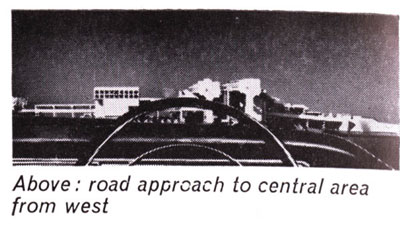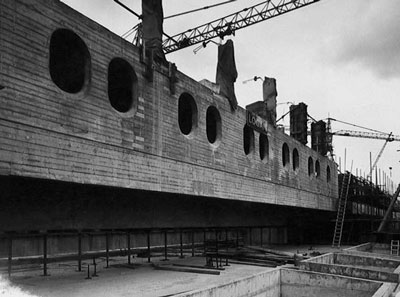

"People
like report -type reports , don’t
they? It’s better than real life."
After
30 years hard labour Cumbernauld was in fact in retrospect a joy.
You stir a rush of thoughts. I’m sitting in a pair of shorts, arm-wrestling
mosquitoes.
Cumbernauld to me was an obsession in a family setting. Hugh the father.
Didn’t
you and I arrive the same day and we tossed up for housing or the centre?
By heaven I must have been hard to work with."
correspondence between Geoff Copcutt and Derek Lyddon, 1995
Cumbernauld New Town Centre in retrospect
Geoffrey Copcutt (1995 paper)
In the Beginning
Arm-wrestling Third World bugs 8000 miles East of those cool Cumbernauld
slopes, I keenly recall returning from an early exploration to fold
a single sheet
of paper into a form which gathered dimensions the Queen would come
to baptise, and Prince Philip to blitz as "bloody concrete."
We were building a cheap town in severe conditions for a lengthening
queue of Clydesiders. I never doubted the logic of a central infrastructure
of
highways and walkways, layers and ledges promising shelter, warmth
and family freedom.
The Future Unfolds
The paper prototype passed from passion to obsession. Hugh Wilson the
father kept the faith. Deputy Dudley Leaker kept the peace. In the
end, both had
to decide to do a caesarian, to get the drawings out of me and up to
the excavations.
The paradox of an open citadel was too commanding to risk compromise.
So with colleague Alex Kerr, I shamelessly did night classes poaching
statistics
and
traffic planning. By day we engaged rowdy academics on a 100-towns retail-social
study, and spent weekends recording the wind regime and sampling test
bores. In between, we debated income and spending patterns, projected
travel modes,
deliveries and solid waste values, juggled structural grids to match
parking modules, mitigated venturi effects and correlated tenant, corner
shop, and
sub-centre distribution to match the first phase.
And all the while, like a jeweller fashioning precious metal, I hammered
the cross-sections and shaped landscape, to form an urban morphology.
Friends, Romans, Countrymen
With the succession of roles came a succession of contributions, evidenced
in the footprint of Alex Kerr and the fingerprints of Dave Brindle, in
the texts
of Alan McCullough and the context of Kilspindie. This fraternal gallery
frames professors Hendry (physics, Liverpool), Diamond (economics, Glasgow),
and Broady
(sociology, ditto). Over the mantelpiece hangs John Faber, son of Oscar
the engineer. Without his fun and flair, even the filleted version of
the first
phase might
have never been built.
Perhaps infected by the interest of Scottish Development Department guru
Bob Grieve, our own administrators took 'air rights' in their stride;
schooled in
municipal halls, they found themselves assembling take-apart models like
born-again believers. Every accent, including echoes of the legions of
Antonius, was heard
as a band of luminaries from Pier Luigi Nervi, Roma, to Lewis Mumford,
Flushing, brought their harps to the studio. They came to witness the
evolution of
a nine-level package accomodating most of the commercial, civic, cultural,
and recreational
uses for a population of 70,000, elevated over a vehicular system linked
to radials a mile apart. Occupying 150 acres of the ridge and upper south
slope between
interchanges, its organisation was to be justified by exposure, topography,
flexibility of functions, pedestrian separation and the need for vehicle
discipline.
Cold Feet
By the time the first phase was committed, my train was departing Glasgow
for Belfast, and a second chance to make a city of our time. Meanwhile,
back at
the Big Hoose, a near top-to –bottom revamp left the Centre under other management.
What next? Reyner Banham's 'Age of the Masters' gives the answer "...there
won't be much next. What has been built so far is a small fraction of
Copcuttt's original design, but it seems all that is going to be built
in this particular
mega-mode."
And, although Banham doesn't say it, this fragment- still big enough
to define a future- was shorn not only of its second row of pylons and
penthouses,
with a host of functional and spatial consequences, but also of the mosaic
of sites
I had tucked in for flea-markets, the winter-garden front to the tiers
of offices, the tube roof illuminating the chapel, the glistening 'airplane
wing' which was
to have tilted open over the library, and even the wall of dwellings
with
upper promenade designed to curtain the parkland. The curved and stepped
terraces of
apartments and earthworks arrayed at the 'Glasgow' portal, I always knew
would take a lot of shaking and moving to make happen. But countless
minor delights
clothing the concept were not so much 'simplified' as simply missed.
Cool Head
Still, how lucky I was to have got the brief. Years earlier, reporting
on the same day, Derek Lyddon and I cordially agreed (Sir Hugh refereeing)
to
toss for
duties. Derek had the pipe, the coin and the call, I had the beard and
the prayer. Out of that spin was to develop a satisfying division of
labour,
and a life-long
respect between us.
Those to whom it may seem that the toss was a poor deal for the Centre
can be consoled that the rest of the town was spared my attentions. Those
to
whom it
seems blindingly obvious that there is little alternative in urban hot-spots
to a decked development, will as easily observe that the execution of
this exemplar was made possible by the awesome powers presented by New
Towns legislation.
From "Rebuilding Scotland" by
Miles Glendinning
Memories from Brian Miller
Geoff Copcutt
was the chief architect for the Town Centre,or the Group Leader for the
Town Centre and he
was basically a loose cannon. There were always shouts from
Hugh Wilson going “ oh god have you not done this….” A couple
of books, one on Glasgow, one of his plans was to cover over the Clyde and
build on that. The library used to have the book, it was a series of projects….
He had very strange ideas.
Like with the town centre model: he had collected these little cornflake
model rockets, placed them around the perimeter for this visiting party
which happened
to be Russians… and I’m almost sure that immediately Cumbernauld
became some red dot on some target chart in Moscow , cos it was seen we had
already
planned the rockets….
Copcutts drawings
They were about 10 yards long, he'd take a roll of this detail paper and pin
it
to the wall.
A bamboo stick with a brush, indian ink, and he did these sketches . I think
he saw himself as an action painter …in concrete…


There was an american fullbright scholar came and lived in Carbrain, name
of
Rod Hardy, he got a book out of it. It’s got all the people writing about
the thing.
AP in queensgate… I got a copy, …
But when Geoff came back from Portadown,and when cumbernauld was doing phase
2 he said a bit disdainfully,
“ oh they’ll just want to extrude Phase 1” like a tube of toothpaste,
and he’d seen it totally different how the town would expand. He’d
changed his ideas a bit, he saw bigger structures, disdained what he had already
produced? Because in a sense I think it was designed to be like that. That it
would just continue.
After he
left I actually took over his office- and he got the job at Portadown building
a
new town there. The laugh was that within the office he
had caused tears
and terrible pressures,architects crying…
You see, the
new towns Stevenage East Kilbride Harlow and so on had happened since 1947.
10
years
later
on Cumbernauld
became
a Mark 2 new town, And it seemed to break the logjam. Subsequently Hugh
Wilson left, Skelmersdale Runcorn and all that had happened so there
was a constant flow of architects
that had got stuck at a financial level, could move to another New Town
and get better wages.
So planner Ben Prince, who’d put forward the proposal for the University
on the Hill, he went for the job at Portadown as did Geoff. So they met
at the airport: Geoff had had his white suit, or his deckchair checkered suit,
and Ben
almost fell over cos geoff arrived in a tail-coat- you know, pinstripe
morning coat and trousers. Gone to Moss Bros and ordered that. “going
to meet the Irish Government, got to look good.” So he arrived, ben was
interviewed, then Geoff was interviewed.
So all these NI civil servants asked him “Mr Copcutt-for offices would
you just use the same kind of system as Cumbernauld?’ He says”NoNo…Harland
and Wolf! Aluminium domes! Bring them on to the site by helicopters.’ (laughter)
These civil servants just fell in love with this man.
“ We’re just going to tip the whole town so it can look at the loch. “
And what happened was he got the job there and then. So they said.”would
you like to stay on a few days and interview the rest of your staff?’
So then all these architects who were trying to escape from Cumbernauld
arrived in this room with Geoff who was by now looking slightly more
disshevelled in this tailcoat…..” Oh
Naw!
I did a google search, there’s this fantastic document where he
turns round and says
‘ the moneys’ been mis-spent, it should be put in to Derry. You shouldn’t
build a new town.” It was a town of 7000 catholics and 8000 protestants.
so planners go and look, do the sums. In that part of Ireland there were
huge numbers of people with no vote,
So many of these planners were absolutely shocked, they’d never come
across this sort of thing . And so geoff within a year told them “no,
I’m
not going to do this” he did something outside Dublin and then
disappeared.
Don’t know where he is...